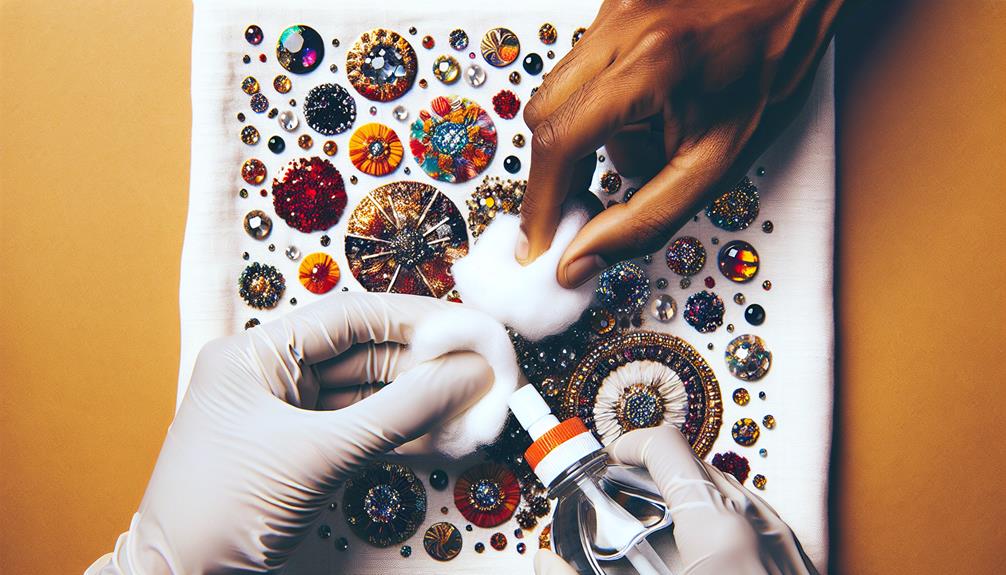As I stared at the puffy paint stubbornly clinging to my favorite shirt, I couldn't help but feel a pang of frustration.
But fear not, for I discovered a few tricks that might just save the day. From gentle scraping to strategic blotting, there's a method to this madness.
Stick around to uncover the secrets of bidding farewell to puffy paint stains without bidding adieu to your cherished fabrics.
Table of Contents
Key Takeaways
- Different puffy paint types require specific removal techniques.
- Essential tools like a dull knife and hard-bristled brush aid in removal.
- Safe techniques involve gentle scraping, brushing, and varnish remover use.
- Prevent future mishaps by storing puffy paint properly and maintaining it well.
Types of Puffy Paint
When working with puffy paint, it's essential to understand the different types available to achieve the desired raised texture effect. Puffy paint is a unique type of fabric paint that, when heated, puffs up to create a three-dimensional look on the fabric. It comes in various colors and finishes like glitter, metallic, and neon, offering a wide range of creative possibilities for your projects.
To remove fabric paint, especially puffy paint, from clothing or other textiles, it's crucial to choose the right type of paint remover or cleaning method. Some puffy paints are designed to be permanent and may require more intensive removal techniques, while others are meant to be easily washable. Understanding the type of puffy paint you used will help you determine the best way to remove it without damaging the fabric.
Before attempting to remove puffy paint, always check the manufacturer's instructions or recommendations for the specific type of paint you're dealing with. This knowledge will ensure a successful removal process and preserve the integrity of your fabric.
Tools Needed for Removal
When it comes to removing puffy paint stains, having the right tools is crucial.
From a dull knife to a varnish remover, each item serves a specific purpose in the removal process.
Let's explore the essential tools needed to tackle those stubborn puffy paint stains effectively.
Cleaning Supplies Required
To effectively remove puffy paint, gather essential cleaning supplies such as a dull knife, a hard-bristled brush, a damp cloth, a spoon, varnish remover on a sponge, and a dry cloth. These tools will aid in efficiently tackling the paint removal process.
Cleaning Supplies Required:
- Dull Knife or Hard-Bristled Brush: Ideal for scraping off excess paint without damaging the fabric.
- Damp Cloth: Essential for blotting the stained area and preparing the surface for cleaning.
- Spoon: Handy for scooping up any excess paint that may come off during removal.
Having these supplies ready ensures a smooth and effective removal process, especially when dealing with fabric paint on clothing.
Safe Removal Techniques
For effective removal of puffy paint, gather the necessary tools such as a dull knife, a hard-bristled brush, a damp cloth, a spoon, and varnish remover on a sponge. When removing puffy paint, it's essential to handle the process carefully to avoid damaging the surface underneath. Here is a helpful table outlining the tools needed for safe removal:
| Tools | Purpose |
|---|---|
| Dull knife | Scrape away excess paint gently |
| Hard-bristled brush | Assist in loosening paint particles |
| Damp cloth | Moisten the surface before removal |
| Spoon | Scoop up excess wet paint |
| Varnish remover on a sponge | Effectively loosen paint particles |
Remember to test any cleaning solutions on a hidden area first, and always blot the stain to prevent it from spreading further.
Preventing Future Paint Use
To prevent future paint use mishaps, ensure proper storage and maintenance of your puffy paint supplies. Here are three essential tips to help you keep your paint in top condition:
- Store in a Cool, Dry Place: Keep your puffy paint in a cool, dry area to prevent accidental spills and leaks.
- Use Airtight Containers: Store any excess paint in airtight containers or resealable bags to maintain its freshness and prevent premature drying.
- Avoid Direct Sunlight: Keep your paint away from direct sunlight and heat sources to prevent it from drying out or thickening too quickly.
Removing Puffy Paint From Fabric
When tackling the task of removing puffy paint from fabric, remember to first scrape away any excess paint gently to prevent fabric damage. Using a dull knife or hard-bristled brush can help lift the paint without harming the fabric.
Once you've removed as much excess paint as possible, blot the stained area with a damp cloth. This will moisten the surface, making it easier to remove the remaining paint. If the paint has dried, be cautious not to scrub too vigorously to avoid damaging the fabric fibers.
To further aid in the removal process, consider using a varnish remover on a sponge to loosen puffy paint particles before machine-washing the fabric. It's also advisable to check the garment care tags for specific instructions on removing puffy paint from different types of fabrics.
Removing Puffy Paint From Clothes
When it comes to removing puffy paint from clothes, knowing the right stain removal techniques can make all the difference.
From gentle scraping to machine-washing tips, these methods can help restore your garments.
Stay tuned for practical directions on how to handle puffy paint stains effectively.
Stain Removal Techniques
For effective removal of puffy paint from clothes, consider gently scraping off any excess paint with a dull knife or brush to prevent fabric damage.
Here are some stain removal techniques to help you tackle those stubborn paint stains:
- Blotting Technique: Dampen a cloth and gently blot the stained area to moisten the surface before attempting to remove the puffy paint.
- Varnish Remover Method: Use varnish remover on a sponge to loosen puffy paint particles, making it easier to remove during machine-washing.
- Avoid Vigorous Scrubbing: Be cautious not to vigorously scrub dried puffy paint to prevent fabric damage while trying to remove the stain.
Remember to check the garment care tags for specific instructions on effectively removing puffy paint stains.
Washing Machine Tips
To tackle the challenge of removing puffy paint from clothes using a washing machine, it's crucial to start by checking the garment care tag for machine-washable instructions. Ensure the fabric can withstand machine washing.
Place the garment in the washing machine alone to prevent spreading the paint to other items. Opt for cold water and a gentle cycle setting to safeguard the fabric from further damage. Add a mild detergent suitable for the fabric type to assist in removing the paint.
Once washed, air dry the garment to evaluate if the paint stain has been completely eliminated. By following these washing machine tips, you can increase the chances of successfully removing puffy paint from your clothes.
How to Remove Puffy Paint From Skin
Using a gentle brush or cloth, I recommend washing the affected area with soap and warm water to effectively remove puffy paint from your skin. Here are three steps to help you get rid of the paint without harming your skin:
- Gently Scrub: Use a soft brush or cloth to gently scrub the area where the puffy paint is. This will help lift off the paint without causing irritation to your skin.
- Oil-Based Solution: Consider using a mild oil-based product such as baby oil or coconut oil. These oils can help dissolve and remove the paint from your skin without harsh chemicals.
- Avoid Harsh Methods: Refrain from using harsh chemicals or scrubbing too vigorously, as this can lead to skin irritation or damage. It's essential to take a gentle approach to protect your skin while removing the puffy paint.
Getting Puffy Paint Off Surfaces
When tackling the task of removing puffy paint from surfaces, employing gentle techniques is key to preserving the integrity of the material underneath. To effectively remove puffy paint, it's crucial to work carefully and patiently. Here are some steps and tools you can use to get puffy paint off surfaces:
| Tools | Techniques |
|---|---|
| Dull knife or brush | Scrape off excess puffy paint |
| Damp cloth | Blot the painted area |
| Varnish remover | Apply on a sponge to loosen paint particles |
| Spoon | Scoop up any excess paint |
| Gentle scrubbing | Avoid vigorous scrubbing to prevent surface damage |
When dealing with wet puffy paint on surfaces, it's essential to act promptly. Begin by gently scraping off any excess paint using a dull knife or brush. Then, dampen a cloth and blot the painted area to lift off any remaining paint. If needed, apply varnish remover on a sponge to help loosen paint particles for easier removal. Remember, the key is to be gentle and avoid harsh scrubbing to protect the surface underneath.
Removing Puffy Paint From Glass
When it comes to removing Puffy Paint from glass surfaces, the key is to delicately scrape off any excess paint using a razor blade.
After that, I recommend using rubbing alcohol on a cotton ball to dissolve the remaining paint residue.
Remember to wipe the glass clean with a damp cloth to ensure a spotless finish.
Use Razor Blade
Gently sliding a sharp razor blade at a 45-degree angle is an effective method for removing dried puffy paint from glass surfaces. Remember to:
- Ensure the razor blade is sharp to prevent scratching the glass.
- Maintain a steady hand and use light pressure to avoid damaging the glass.
- Wipe the glass clean with a damp cloth post-removal to get rid of any remaining puffy paint residue.
Using a razor blade with caution and precision will help achieve smooth results when removing puffy paint from glass. It's essential to handle the blade carefully to avoid any accidents and ensure a clean finish.
Apply Rubbing Alcohol
To seamlessly transition from using a razor blade to remove dried puffy paint from glass surfaces, applying rubbing alcohol proves to be an effective method for dissolving and wiping away the paint residue.
Start by dampening a clean cloth or cotton ball with a small amount of rubbing alcohol. Gently dab the affected area, allowing the alcohol to break down the paint's adhesive properties.
Then, using circular motions, softly rub the puffy paint to lift it off the glass surface. If needed, repeat the process until the paint is completely removed.
Tips for Removing Puffy Paint
For effective removal of puffy paint stains, start by gently scraping away any excess paint using a dull knife or brush to prevent fabric damage.
Here are some tips to help you effectively tackle puffy paint mishaps:
- Blot the stain: After scraping off excess paint, blot the stained area with a damp cloth to lift more of the paint. Use a spoon to scoop up any released paint gently.
- Utilize varnish remover: Apply varnish remover on a sponge to help loosen puffy paint particles before machine-washing the fabric. This can aid in breaking down stubborn stains effectively.
- Handle wet paint carefully: When dealing with wet puffy paint, blot the area with a cotton swab, rinse under warm water, and use a stain remover if necessary. This approach can help prevent the stain from setting in and becoming harder to remove.
Quick Fixes for Puffy Paint Mishaps
When addressing puffy paint mishaps, quick fixes can make a significant difference in effectively managing stains and spills.
To tackle wet puffy paint stains, start by blotting them with a cotton swab to swiftly absorb excess paint. Next, rinse the reverse side of the fabric under warm water to aid in loosening and removing the paint. For stubborn stains, sprinkle detergent on the affected area and gently blot with a sponge for more effective removal. If the stain persists, consider using a cleaning solution specifically designed for fabric paints before machine-washing for a thorough cleanup.
In the case of dried puffy paint stains, act promptly by moistening the paint, using varnish remover if necessary, and then proceed with machine-washing following the care instructions. These quick fixes offer practical solutions to address different puffy paint mishaps efficiently.
Safely Removing Puffy Paint
When safely removing puffy paint, start by scraping away any excess paint using a dull knife or hard-bristled brush. If the paint is still wet, follow these steps for safe removal:
- Blotting: After scraping off excess paint, blot the stained area with a damp cloth to absorb as much paint as possible.
- Scooping: Use a spoon to scoop up any remaining paint particles that have been loosened during the scraping process.
- Rinsing: Rinse the fabric under warm water, focusing on the reverse side to push out any remaining paint. Avoid using hot water as it can set the paint further into the fabric.
Preventing Puffy Paint Mishaps
To prevent puffy paint mishaps, ensure proper preparation and protection measures are in place before starting your project. Here are some key tips to safeguard your working area and prevent any unwanted paint spills or splatters:
| Protection Measures | Description | Benefits |
|---|---|---|
| Use painter's tape | Protect areas where you don't want paint spread | Prevents accidental spills |
| Work on a covered surface | Use a drop cloth or newspapers | Avoids paint spills on surrounding areas |
| Wear old clothes or an apron | Shield clothing from potential splatters | Keeps your clothes clean |
| Keep a damp cloth handy | Quickly wipe off accidental spills | Prevents paint from drying on affected areas |
| Ensure good ventilation | Avoid inhaling puffy paint fumes | Promotes a healthier work environment |
Frequently Asked Questions
Is Puffy Paint Permanent?
Puffy paint can vary in permanence based on factors like fabric type and paint composition. Some options are removable with water, heat, or solvents, while others offer long-lasting designs. Proper care extends lifespan.
How Do You Get Puffy Paint to Dry?
To get puffy paint to dry effectively, ensure proper ventilation, avoid disturbances, and follow manufacturer's guidelines. Patience is key; allowing air-drying time or gently using indirect heat speeds up the process without compromising the paint's quality.
How Do You Fix Puffy Paint Mistakes?
I fix puffy paint mistakes by gently scraping excess with a dull knife or brush, then blotting with a damp cloth. Using varnish remover on a sponge helps loosen paint particles for easier removal. Avoid scrubbing to prevent fabric damage.
Can Fabric Paint Be Removed?
Fabric paint can be removed with prompt action and suitable techniques tailored to its type. Wet stains are easier to tackle. Testing on a small area is wise. Stubborn stains might need professional help.
- Tetron Fabric in Delhi: Where to Find It - June 17, 2025
- Tetron Fabric Vs Other Fabrics: a Comparative Analysis - June 17, 2025
- Creative Uses for Tetron Fabric in Fashion and Home Decor - June 17, 2025






